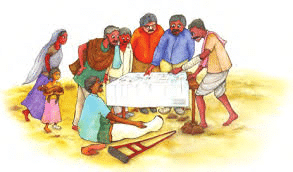When the Earth Shook - 2 Class 5 Worksheet EVS Chapter 14

Multiple Choice Questions
(i) What was the primary suggestion given by engineers and architects to rebuild houses after the earthquake?(a) Build houses with clay and cow dung
(b) Use plastic tents as permanent homes
(c) Follow special designs to make houses safer in earthquakes
(d) Build houses with multi-storeyed structures
Ans: (c)
After the earthquake, engineers and architects suggested building houses with special designs that could withstand future earthquakes. This was to ensure the safety of the villagers and reduce damage during similar natural disasters.

(ii) What was the role of scientists who visited Jasma's village after the earthquake?
(a) Provide food and clothing
(b) Study which areas are prone to earthquakes
(c) Treat injured people in the village
(d) Help rebuild the school
Ans: (b)
Scientists visited the village to study which areas were more prone to earthquakes. This knowledge would help in better planning and preparedness to avoid similar disasters in the future.
(iii) Why were plastic tents used in Jasma's village?
(a) To replace houses permanently
(b) To protect people from the cold temporarily
(c) To store food grains
(d) To treat injured people
Ans: (b)
After the earthquake destroyed houses, villagers stayed in plastic tents provided by relief groups as temporary shelters. These tents protected them from the cold winter nights until permanent houses could be rebuilt.
(iv) According to the TV report, which city was most severely affected by the earthquake?
(a) Bhuj
(b) Ahmedabad
(c) Rajkot
(d) Gandhinagar
Ans: (a)
The TV report stated that Bhuj was the worst affected area during the earthquake. People were in shock, and there was significant damage to lives and property compared to other cities.
Match the Following

Ans: 
True-Life Application Based Questions
(i) Imagine your city experiences a sudden natural disaster like an earthquake or flood. What steps would you take to protect yourself and your family?
Answer: I would first ensure that all family members are accounted for. If the disaster occurs indoors, I would move under a sturdy piece of furniture to protect myself from falling debris. I would then assess the safest exit route to leave the house and go to an open area. I would also have an emergency kit prepared with food, water, and first aid supplies.
(ii) If a disaster like the earthquake described in the passage occurs in your area, who would you reach out to for help and what kind of help would you need?
Ans: I would reach out to local emergency services like the police, fire department, and medical teams for immediate help. I would need assistance with finding shelter, food, water, and medical attention for injuries. I would also reach out to community organizations for emotional support and rebuilding efforts.
(iii) In the event of a natural disaster, how would you assist your community and support the recovery process, based on the actions in Jasma’s village?
Ans: I would help by volunteering for rescue operations, providing first aid to the injured, and distributing food and water to those in need. I would also assist in rebuilding efforts by helping organize work groups and contributing to the physical reconstruction of homes and public spaces. I would stay informed and assist in guiding others on safety protocols.
Passage Based Questions
"For some days after that, people from the cities kept coming to see what had happened. They came with food, medicines and clothes. Everyone used to rush to take these things. The clothes that we got were very different. We had never worn such clothes before. People from different groups from the city, helped us to put up the tents. Staying in these plastic tents in the cold winter months was very difficult.
Some of these people were scientists. They tried to find out which areas have more chances of having an earthquake. People from our village talked to them many times. They had suggestions about building our houses again. Engineers and architects showed us some special designs for houses. They said that with this design, houses would not get damaged much in an earthquake. But our people were a little afraid. They thought if these people build our houses, our village will not look like our old village. So, the villagers thought they would build their own houses with their help. The groups would build the village school.
We all worked together to rebuild our village. Some people dug and brought the clay from the pond. We mixed the clay with cow dung and made large cakes. We put these on one another to make the walls. We whitewashed the walls and decorated them with beautiful designs and small pieces of mirrors. We put up the thatched roof. Now our house shines like a diamond in the dark night!"

(i) According to the passage, how did the villagers react immediately after the earthquake? How did they manage to survive the initial chaos?
Ans: The villagers reacted with panic and fear, not knowing what was happening or how to react. They immediately tried to save people who were trapped under the debris and treated the injured. Despite the devastation, the villagers worked together, with help from the local doctor and community, to provide basic medical treatment.
(ii) What role did the city volunteers and engineers play in the aftermath of the earthquake in Jasma's village?
Ans: The city volunteers provided essential aid such as food, clothes, and medicines. Engineers and architects played a key role in suggesting safe house designs that would prevent further damage in case of future earthquakes. The engineers also helped with rebuilding efforts, ensuring that the houses were constructed to be earthquake-resistant.
(iii) How did the villagers rebuild their homes, and what materials did they use to make them strong again?
Ans: The villagers used clay from the pond, mixed with cow dung, to create large bricks. They then stacked these bricks to form the walls of their houses, whitewashed the walls, and decorated them with designs and pieces of mirrors. The roofs were thatched to complete the structure, creating a safe and sturdy home for the future.
|
53 videos|388 docs|51 tests
|
FAQs on When the Earth Shook - 2 Class 5 Worksheet EVS Chapter 14
| 1. What causes earthquakes and how do they occur? |  |
| 2. What are the different types of earthquakes? |  |
| 3. How can we measure the magnitude of an earthquake? |  |
| 4. What safety measures should be taken during an earthquake? |  |
| 5. How can communities prepare for earthquakes? |  |






















